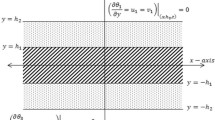Abstract
Second-order forms for the material response functions of an elastic heat conductor are derived by approximating the response functions by polynomials in the appropriate invariants. Solutions based upon these forms of the response functions are exact for special materials and approximate for general materials. The second-order dependence on temperature of isothermal elasticity solutions is found, and the results are shown to agree well with experimental data taken on rubber. Within the second-order theory for incompressible and isotropic bodies, the problems of biaxial stretching of a plate with transverse heat flow and the simultaneous extension and shear of a cylindrical annulus with radial heat flow are solved.
Résumé
Les termes du deuxième ordre des fonctions de réponse d'un conducteur de chaleur élastique sont dérivés dans une approximation basée sur le développement en polynomes d'invariants appropriés de ces fonctions. Les solutions qui en résultent sont exactes pour certains matériaux et approchées dans le cas général. Une dépendance du second ordre en température de l'élasticité isotherme est établie et il est montré que, dans le cas du caoutchouc, les résultats sont en bon accord avec les données expérimentales. Les problèmes de l'état de tension bidimensionnel d'une plaque soumise à un flux de chaleur transversal et de l'allongement et du cisaillement simultanés d'un anneau cylindrique parcouru par un flux radial sont résolus dans le cadre de la théorie du second ordre pour les corps incompressibles et isotropes.
Similar content being viewed by others
References
H. J. Petroski andD. E. Carlson,Controllable States of Rigid Heat Conductors, Z. Angew. Math. Phys.19, 372–376 (1968).
H. J. Petroski andD. E. Carlson,Controllable States of Elastic Heat Conductors. Arch. Rational Mech. Anal.31, 127–150 (1968).
H. J. Petroski andD. E. Carlson,Some Exact Solutions to the Equations of Non-Linear Thermoelasticity. J. Appl. Mech.37, 1151–1154 (1970).
N. Laws,Controllable States in Thermoelasticity. Quart. Appl. Math.28, 432–436 (1970).
F. D. Murnaghan,Finite Deformation of an Elastic Solid. Amer. J. Math.59, 235–260 (1937).
R. S. Rivlin, ‘Some Topics in Finite Elasticity’.Proc. of the First Naval Symp. on Structural Mech., Pergamon Press, New York (1960), pp. 169–198.
S. Singh,Small Finite Deformations of Elastic Dielectrics. Quart. Appl. Math.25, 275–284 (1967).
O. W. Dillon,A Nonlinear Thermoelasticity Theory. J. Mech. Phys. Solids10, 123–131 (1962).
G. Herrmann,On Second-order Thermoelastic Effects. Z. angew Math. Phys.15, 235–262 (1964).
P. Chadwick andL. T. C. Seet,Second-order Thermoelasticity Theory for Isotropic and Transversely Isotropic Materials. In Trends in Elasticity and Thermoelasticity (ed. R. E. Czarnota-Bojarski, M. Sokolowski, and H. Zorski), Walters-Noordhoff, Groningen (1971).
P. Yarrington andD. E. Carlson,Successive Approximations in Nonlinear Thermoelasticity. Int. J. Engng. Sci.14, 113–125 (1976).
B. D. Coleman andW. Noll,The Thermodynamics of Elastic Materials with Heat Conduction and Viscosity, Arch. Rational Mech. Anal.13, 245–261 (1963).
L. R. G. Treloar,The Physics of Rubber Elasticity. 2nd ed., Clarendon Press, Oxford (1958).
R. S. Rivlin andD. W. Saunders,Large Elastic Deformations of Isotropic Materials, VII. Experiments on the Deformation of Rubber, Phil. Trans. Roy. Soc. Lond., A243, 251–288 (1951).
Baker, M. andJ. L. Ericksen,Inequalities Restricting the Form of the Stress-Deformation Relations for Isotropic Elastic Solids and Reiner-Rivlin Fluids. J. Wash. Acad. Sci.44, 33–35 (1954).
C. Truesdell andW. Noll, ‘The Non-linear Field Theories of Mechanics’, inHandbuch der Physik, Vol. III/3 (ed. by S. Flügge). Springer-Verlag, Berlin-Göttingen-Heidelberg (1965).
C.-C. Wang andC. Truesdell,Introduction to Rational Elasticity, Noordhoff, Leyden (1973).
R. L. Anthony, R. H. Caston andE. Guth,Equations of State for Natural and Synthetic Rubber-like Materials. J. Phys. Chem.46, 826–840 (1942).
L. R. G. Treloar,The Elasticity and Related Properties of Rubbers. Rep. Prog. Phys.36, 755–826 (1973).
H. H. Erbe,Thermoelastic Effects in Incompressible Isotropic Solids. Mech. Res. Comm.1, 137–142 (1974).
H. J. Petroski,On the Finite Torsion and Radial Heating of Thermoelastic Cylinders. Int. J. Solids Struct.11, 741–749 (1975).
Author information
Authors and Affiliations
Rights and permissions
About this article
Cite this article
Martin, S.E., Carlson, D.E. The behavior of elastic heat conductors with second-order response functions. Journal of Applied Mathematics and Physics (ZAMP) 28, 311–329 (1977). https://doi.org/10.1007/BF01595598
Received:
Issue Date:
DOI: https://doi.org/10.1007/BF01595598




